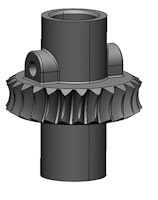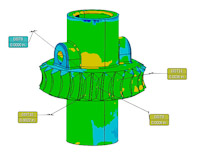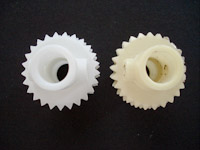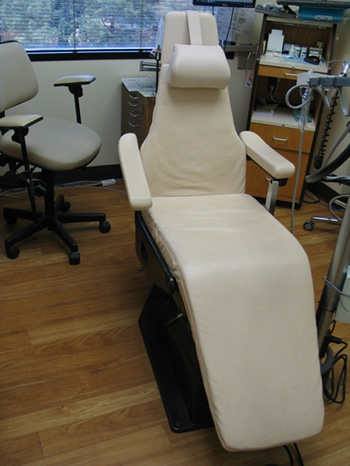3D Scanning and 3D Printing Used in the Restoration of Dental Equipment
Old dental chairs are showing their age, and many of these expensive necessities are no longer operational. The manufacturers, in many cases, abandoned maintenance and repair, so they no longer carry a replacement parts inventory. One such chair is the Planmeca PM2000, which many dentist consider one of the best operating chairs ever made.
One small component made this otherwise good-condition $5,000 dental chair inoperable. Without a replacement part, CAD data or 2D drawings, the dental practice thought its only option was to replace the Planmeca with a new chair. In hopes of finding a better alternative, it contacted Absolute Geometries to investigate 3D scanning and low-cost manufacturing methods.
The culprit was a small, yet complex, nylon gear with badly worn teeth. Upon inspection, Absolute Geometries proposed laser scanning to reverse engineer the gear and 3D printing for prototype evaluation and possibly manufacturing.
Absolute Geometries started the process by scanning the damaged gear with its Faro Laser ScanArm to produce a digital copy of the geometry. This laser scanner takes thousands of 3D measurement points of an object in just seconds. To capture the concave gear teeth, the scanning technician used a dense measurement point spacing (scan spacing) of 0.005 inch.

Original Damaged Gear |

Worn and missing teeth are present |
| |
3D Scan of Gear
 |
3D scanning creates a point cloud from object measurements. Scan registration software, such as Rapidform, connects the points with triangles to form a mesh surface. The mesh file is an exact replication of the part and in most cases is not the kind of data that you would use to reproduce the part. All of the imperfections of the original are in the scan data.
If precise CAD geometry is required, a CAD engineer uses the scan data as a guide to re-engineer the features. The engineer will average the scan data and force features to be exact. For example, they will create holes and cylinders that are perfectly round and will make sure that symmetrical features are equally spaced. This requires experience and knowledge of the original design intent. |
| |
|
Precise CAD model created from scan data
 |

3D color deviation map to check accuracy of CAD data
|
From the scan data, CAD engineers created a precise digital model of the gear and double-checked it for accuracy. The engineers produced 3D color-deviation maps by aligning the new CAD model to the original scan data. The color-deviation map showed any deviations of the CAD file from the scan data. It also documents the amount of deviation. As an additional check, they created several 2D cross-sections through the complex gear to ensure an exact fit.
|
2D section view comparing scan data to CAD model
 |
One of several section views created shows the deformed area of the original gear (red) and the alignment of the new CAD model (green) to the good ortions of the scan data.
Absolute Geometries used Rapidform XOV software to create the deviation maps. Rapidform automatically aligns the scan data to the CAD model and determines where the data differs. |
Now that an accurate CAD model of the gear existed, the manufacturing selection process began. Because of the complexity of the gear shape, machining was not an option. It would have required too many setups, and the cost would have been prohibitive. Hard tooling and injection molding was ruled out because of the limited production volume. Absolute Geometries decided to use 3D printing. It chose the selective laser sintering (SLS) process to build the replacement parts in a nylon material called DuraForm PA.
The SLS process uses a laser to sinter powdered material one layer at a time to form 3D geometry. Initially known as “rapid prototyping,” many companies now use the process for manufacturing. Because no initial tooling is required, it is an excellent manufacturing process when production quantities are low. Production of SLS parts took two days. It would have taken weeks to produce machined parts and months for injection molded plastic.
|
SLS replacement gear
 |
3D printed part compared to original

|
Engineers installed the SLS replacement gear and tested its operation. The gear performed as well as the original, and after one year of operation, it is still working and has no signs of wear. In the early days of rapid prototyping, it would not have been possible to use the technology in this way. Advancements in material properties, machine size, and processing speeds have opened up many new possibilities for the use of 3D printing as a manufacturing process.
|
Restored Planmeca chair
 |
Many other industries benefit from the use of reverse engineering and 3D printing to solve manufacturing problems. Absolute Geometries has completed dozens of these types of projects including:
- Aviation Simulators
- Archery Grips and Risers
- Football Helmets
- Automotive Components
- Space Suit Components
- Sculptures
- Racing Helmets
- Medical Equipment Housings
- Military Weapons Simulators
- Knife and Gun Handles
- Motorcycle Fairings
- Medical Implants
|










